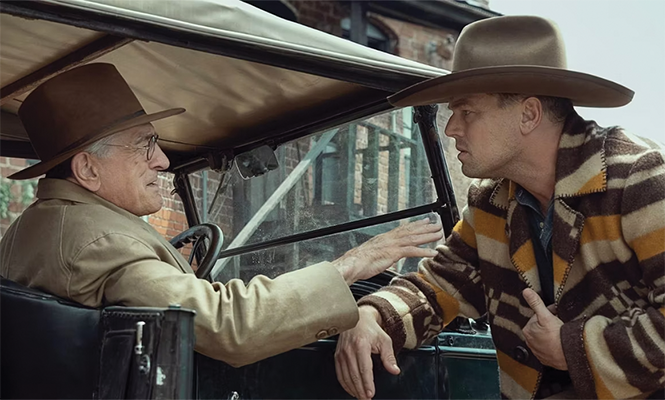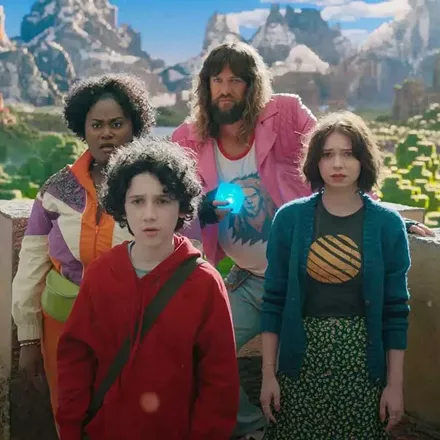Feature film review: Killers of the Flower Moon
Capturing history as racist entitlement killing men's souls
By Scott Renshaw @scottrenshawPerhaps it's not entirely accurate to call David Grann's 2017 book Killers of the Flower Moon a mystery—but maybe at least a little bit, it is. In telling the true-life story of a series of murders and suspicious deaths among the Osage Indians of Oklahoma circa early-1920s, connected to the tribe's immense wealth from oil produced by reservation lands, Grann allows the story and its suspects to unfold slowly, leading up to the investigation by the then-brand-new Federal Bureau of Investigations
In adapting the book, director Martin Scorsese and co-screenwriter Eric Roth have a different kind of story on their minds. It's neither mystery nor spoiler that the mastermind behind the killings is local cattle baron William "King" Hale (Robert DeNiro), or that he involves his nephew Ernest Burkhart (Leonardo DiCaprio), a World War I veteran who eventually marries Mollie (Lily Gladstone), an Osage woman. This is no whodunnit, nor is it even exactly a whydunnit. Instead, it's a story that's in Scorsese's career wheelhouse of narratives about the things that corrupt men's souls.
As a result, Scorsese's Killers of the Flower Moon opts to center neither the Federal agent investigating the crimes—Jesse Plemons' Tom White doesn't make an appearance until the two-thirds mark—nor the Osage people, the latter being a decision that could clearly inspire some finger-wagging. For the most part, it focuses on DiCaprio's Ernest, watching as his simple man of appetites turns into a conspirator in multiple murders. DiCaprio's performance at first feels almost exaggerated in its jaw-forward quality, but that choice feels perfectly in keeping with the thematic center. Ernest just isn't particularly smart, but he's the kind of man who often wins in America because he's ruthless enough to do whatever he thinks he needs to do, self-deluding enough to be able to tell himself it's all "for my family," and White enough to expect that he'd be able to get away with it.
That's not to say that this Killers of the Flower Moon relegates its Osage characters entirely to the status of noble victims. Scorsese and Roth don't shy away from the irony of the Osage being driven from ancestral lands to a desolate place where they end up unexpectedly rich, and the film gives plenty of time to their cultural rituals and even untranslated dialogue. Mostly, they make use of a performance by Gladstone that's rich and understated, observing as her cynicism about White men like Ernest gives way to falling in love with him. It's part of the heartbreak of the film that even as she begins to understand that there's a conspiracy to kill the members of her family, she places her diabetes-plagued ill health in the hands of Ernest alone, convinced that he must be the one person she can trust.
Still, this is fundamentally a story about the evil that men do, and the filmmakers allow every bit of the plotting to unfold in detail, from King making himself the beneficiary of one Osage man's life insurance policy, to a pair of complicit doctors getting a warning call that they might want to remove any valuable belongings from a rented house that's about to be blown up. Scorsese rarely draws attention to his direction through showy camera movements, aside from one long take winding through a house showing a blended White/Osage family as a deceptive suggestion of some kind of peaceful American melting pot. He's out to convey this story as part of a darker tradition—like the Tulsa race massacre of 1921, which is referenced here more than once—of White Americans looking on any wealth accumulated by non-White people as some kind of mistake that they're obliged to correct.
Killers of the Flower Moon ends with a coda that suggests how hard it is to get audiences to take in this kind of history unless it's delivered in an entertaining enough package, and it's here that Scorsese overplays his hand a bit, almost centering his own brave willingness to tell this largely hidden chapter of history. It's a brief misstep, fortunately, and one that's more than offset by a choice to show the way that racism decays into entitlement; Scorsese shows flies frequently buzzing around Ernest like he's already rotting meat. There's no mystery involved in understanding America's original sins, only a need to stare them in the face, and perhaps see one that looks uncomfortably like one's own.
More by Scott Renshaw
-
Comedian Steve Hofstetter interview
Veteran standup talks about getting started, dealing with hecklers, and learning a valuable lesson in SLC
- Apr 11, 2025
-
Film Reviews: New Releases for April 11
The Amateur, Drop, The Ballad of Wallis Island, Warfare, King of Kings, Sacramento
- Apr 10, 2025
-
Movie reviews: THE BALLAD OF WALLIS ISLAND, WARFARE, THE KING OF KINGS
Wars of words, weapons and ideas drive three new theatrical releases
- Apr 9, 2025
- More »
Latest in Film Reviews
Readers also liked…
-
Sundance 2025 wrap-up plus February special screenings
Uncertainty about the future location shifts focus away from the movies
- Feb 5, 2025









